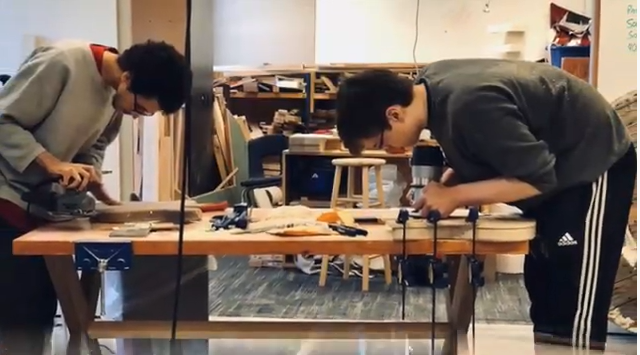Missouri alternative high school achieves personalization through innovation


Editor’s note: You can watch videos of how Liberty High School is rethinking education here and here.
A virtual tour of Liberty High School in Liberty, Missouri, a suburb with a population of 30,167, is as notable for what you don’t see as much as for what is visible.
Instead of traditional classrooms crammed with desks, you’ll see multipurpose spaces with comfy chairs. The walls and ceilings are decorated with student artwork. Teachers collaborate with groups of students on projects and chat about goals for the day.
Rather than responding to a bell schedule, students move freely from area to area and are encouraged to come and go from campus as they practice the skills they’re learning in real life settings, thanks to agreements with more than 100 community business partners.

Social studies teacher Art Smith, a 17-year veteran of Liberty Public Schools and a self-described “crazy guy,” redesigned the 26-year-old alternative high school’s format in 2016 with his colleagues so it would be more in line with what he calls “schools of the future.”
“We’re probably in a period of history where technology is allowing us to rethink schools,” said Smith, who doesn’t shy away from the title “education disruptor.”
During his career, Smith has tried almost every possible way to help kids derive meaning from what they’re learning, from carving canoes to building Conestoga wagons to staging archeological digs. He is among a rapidly expanding breed of educators who believe a break with the established educational model is necessary to improve the existing one.
Though Liberty Academy is a traditional district school, it looks and feels more like a public charter or private school with a model that draws inspiration from the unschooling movement of the 1960s, which encouraged exploration of activities initiated by students themselves. The basic idea is that the more personal learning is, the more meaningful it will be.
Here’s how it works. When students enter the program, they are allowed four weeks to determine their interests and long-term goals. Learning is then organized in six-week bursts of interest-based learning, which often includes participation with one of the school’s community partners in what school officials describe as “a reverse internship.”
Among the partners: a miniature horse farm, a greenhouse operation, cosmetology schools, a homeless shelter, and a host of nonprofit organizations. The aim is to allow students to explore careers, help others, and solve problems.
Students set goals based on three or four success skills during each segment. Teachers, who are referred to as advisers, help students document their growth each week and link their projects to standard and class credits.
At the end of each project, students give a presentation to a panel of at least three adults. At the end of each semester, they write an essay and display artifacts for a school and community showcase.
Learning is project based and competency based; there are no traditional grades and no traditional seven-period day. For staff members, it all adds up to an environment that looks more like life than school.
“Until you come and visit, it’s really hard to describe,” said Summer Kelly, Liberty Schools’ 2020-21 Teacher of the Year. (You can learn more about her here.) “I’m obviously a teacher, but I do way more than just teaching.”
A former middle school math teacher, Kelly left her traditional teaching job in the district three years ago to join the faculty at the alternative high school, which serves about 100 at-risk students.

A typical day starts with physical activity, with a yoga class offered weekly. Afterward, students gather for a “circle meeting” and check in with their advisers and learn about trips available that day. Students then go out in small groups to participate with advisers.
“Nothing about our building is traditional in any way, and I think that’s where I needed the change,” Kelly said. “It gave me new motivation.”
Smith, the social studies teacher who helped redesign the school, said he came to a conclusion early in his career that school needed to look different to be effective, especially for students who don’t like going to school.
“They’re forced to be there, and they’re compliant and sitting in their classroom and sitting in their desks, but a lot of kids weren’t interested in anything happening on a day-to-day perspective, and that bothered me,” he said. “If they don’t love it and don’t feel intrinsically driven to be a part of it, then we should try to build a framework that does that, because no human wants to be a part of something that they don’t have ownership of and empowerment in.”
The school, which has the support of the district and school board, has won several awards and was named a grand prize winner in the 2020 Magna Awards sponsored by the National Association of School Boards. Other nearby districts have taken notice and are seeking to incorporate parts of Liberty’s model.
Said Smith: “I feel blessed to be in this position at this time and to continue pushing the envelope of what school can be for kids.”
The post Missouri alternative high school achieves personalization through innovation appeared first on reimaginED.
